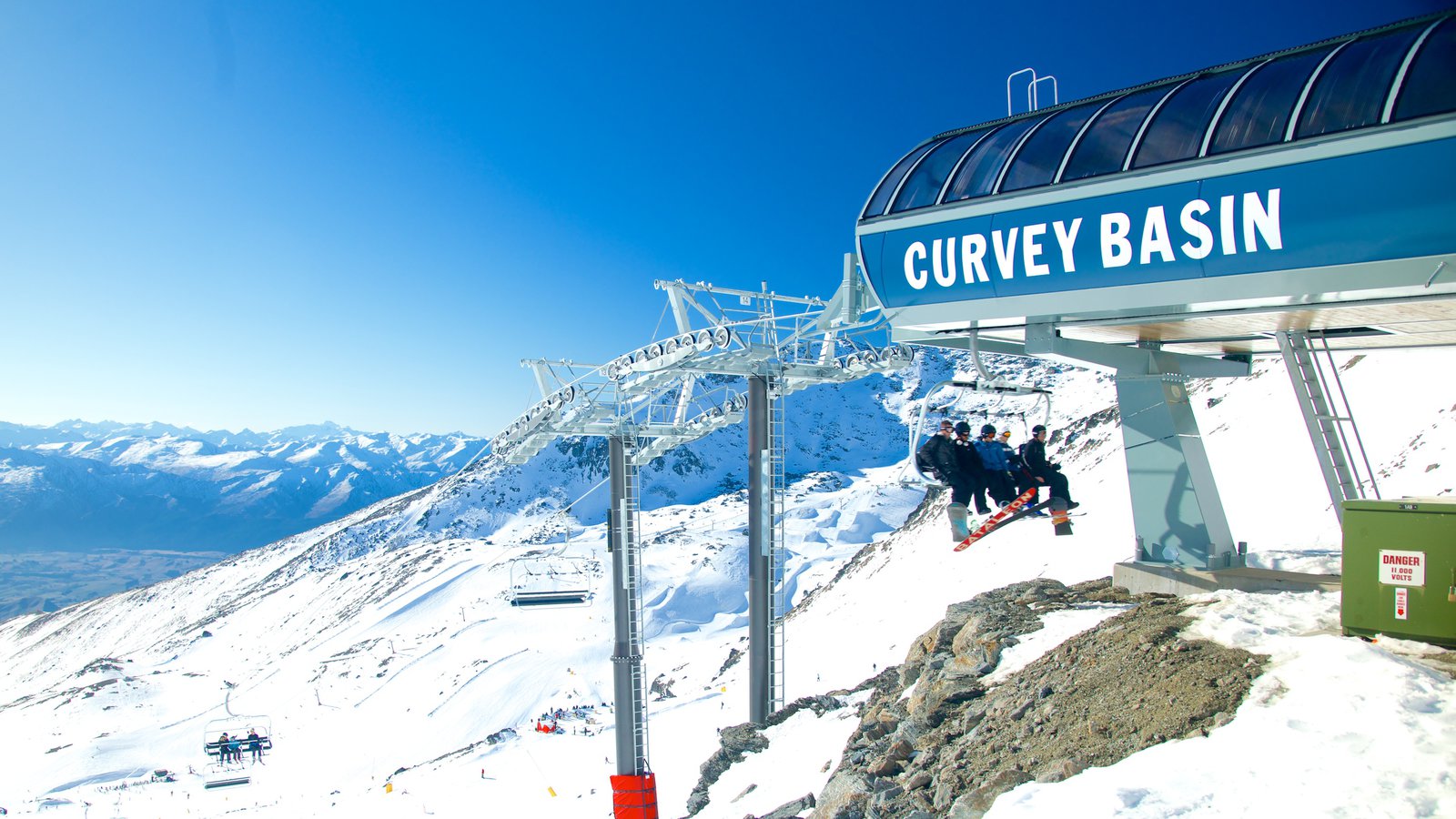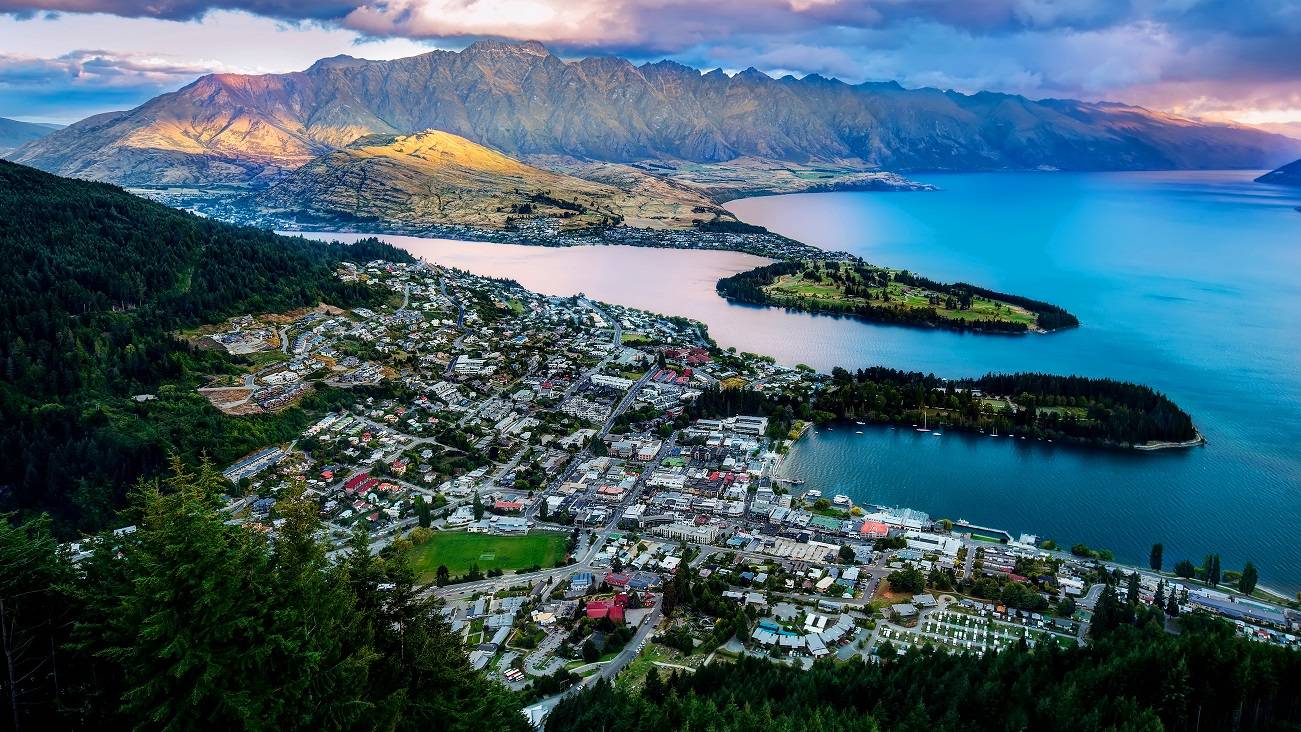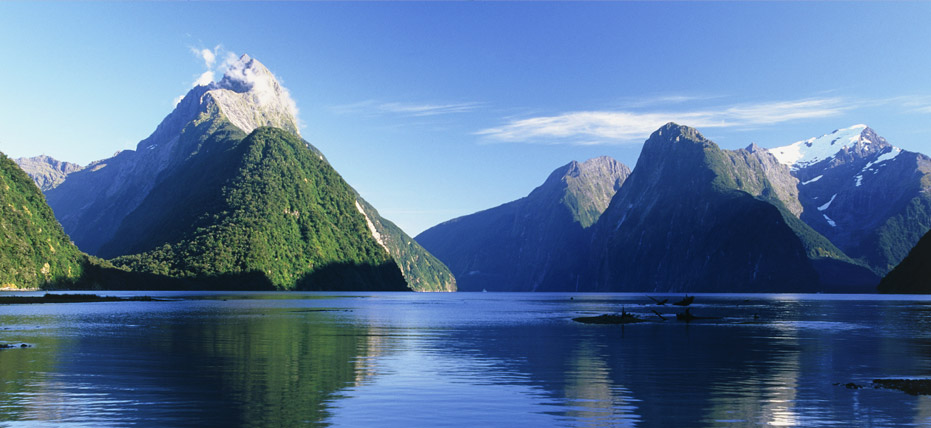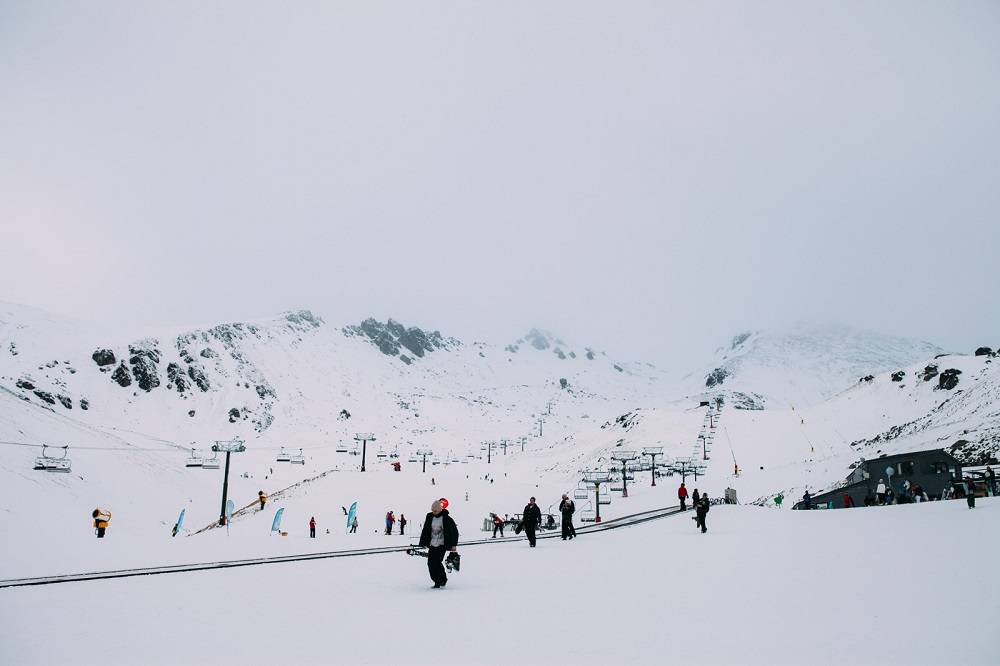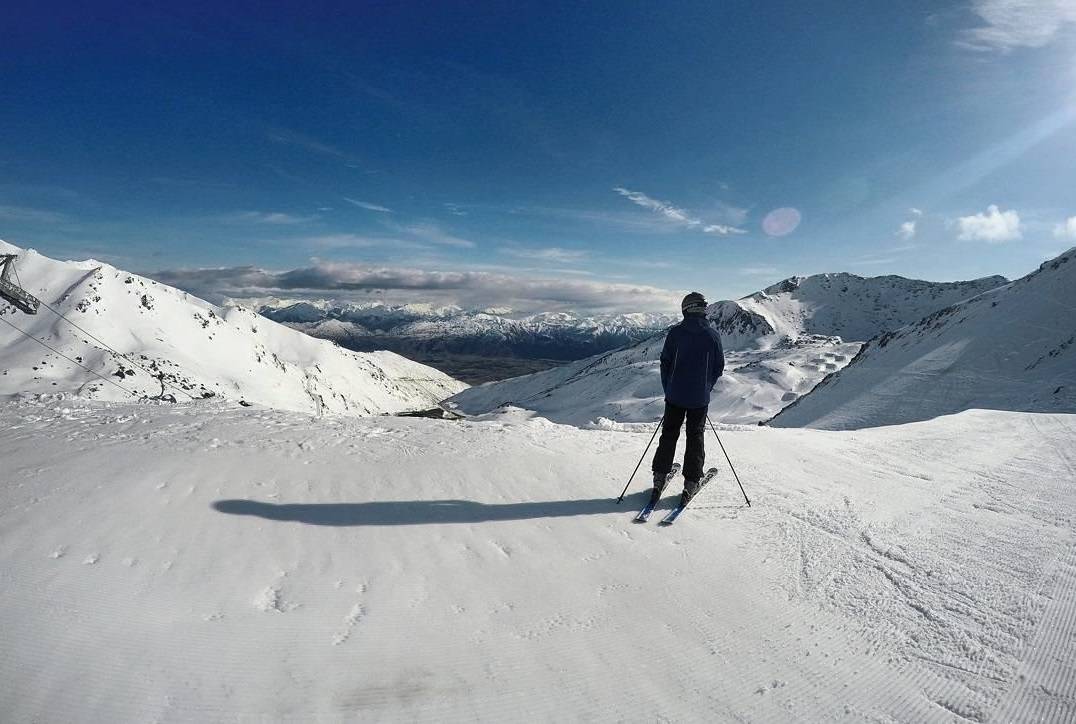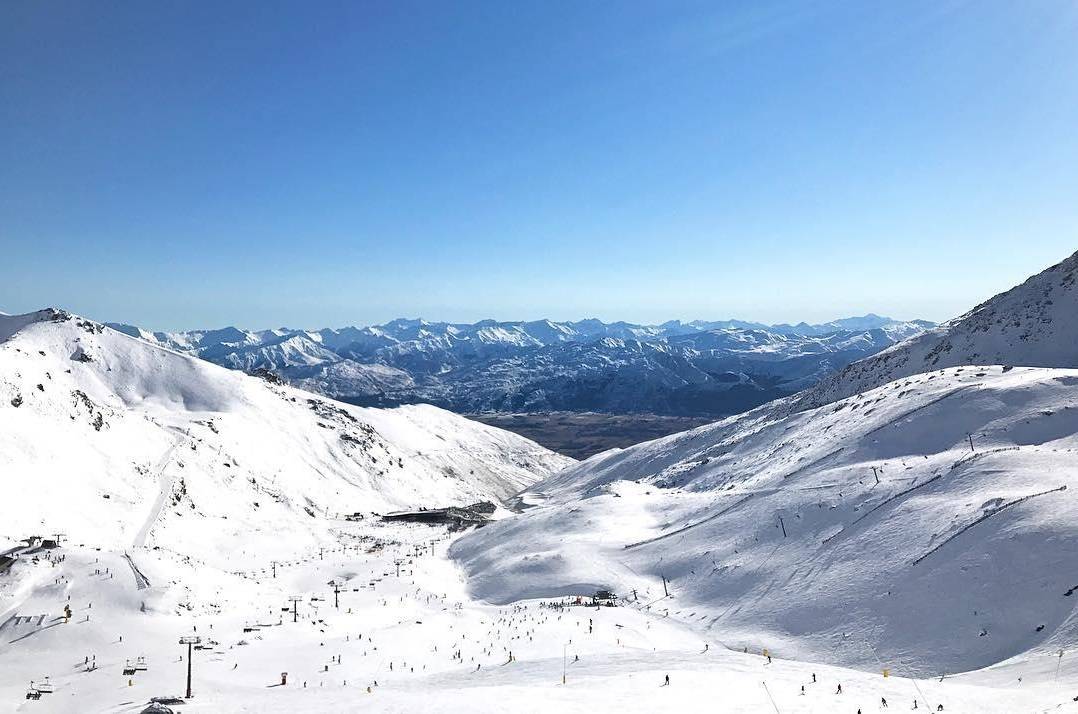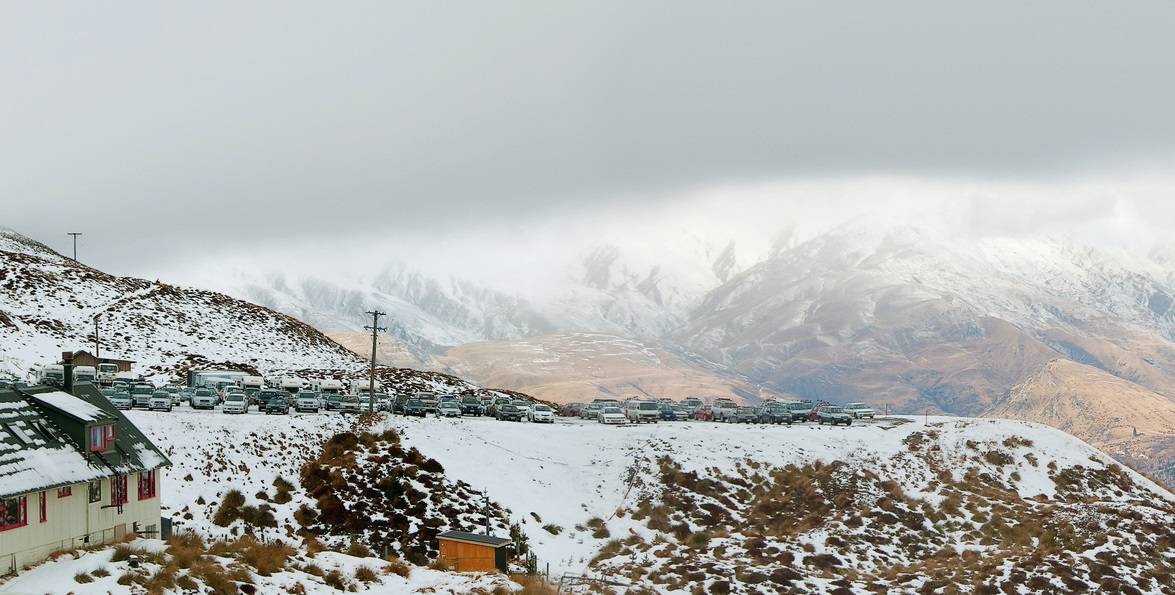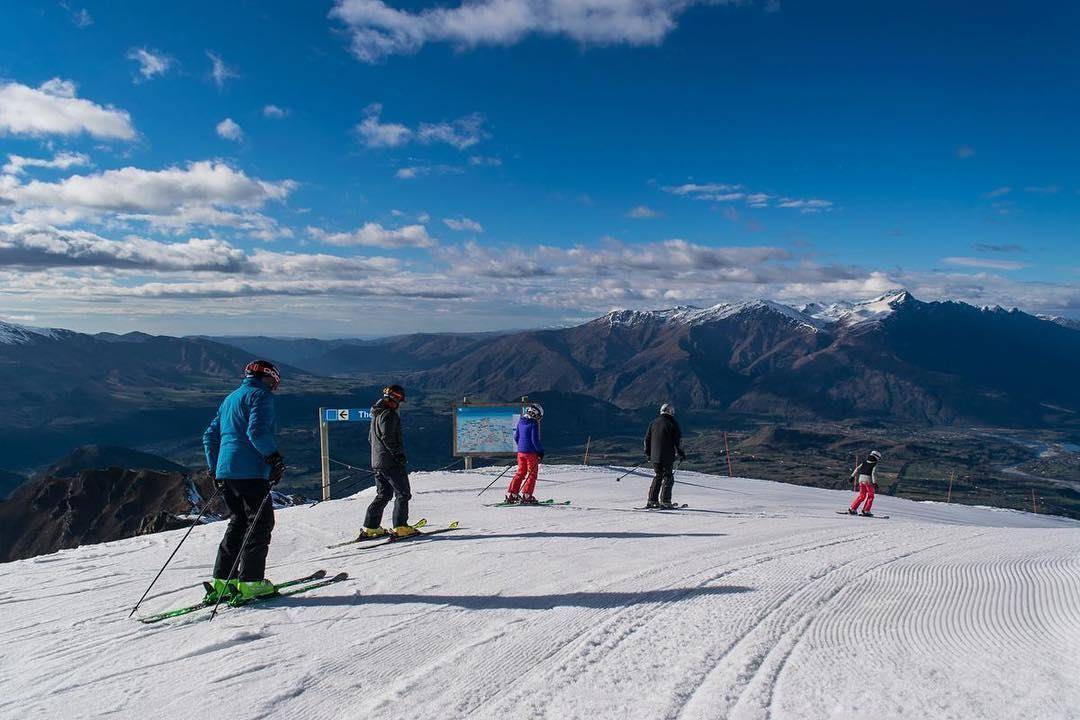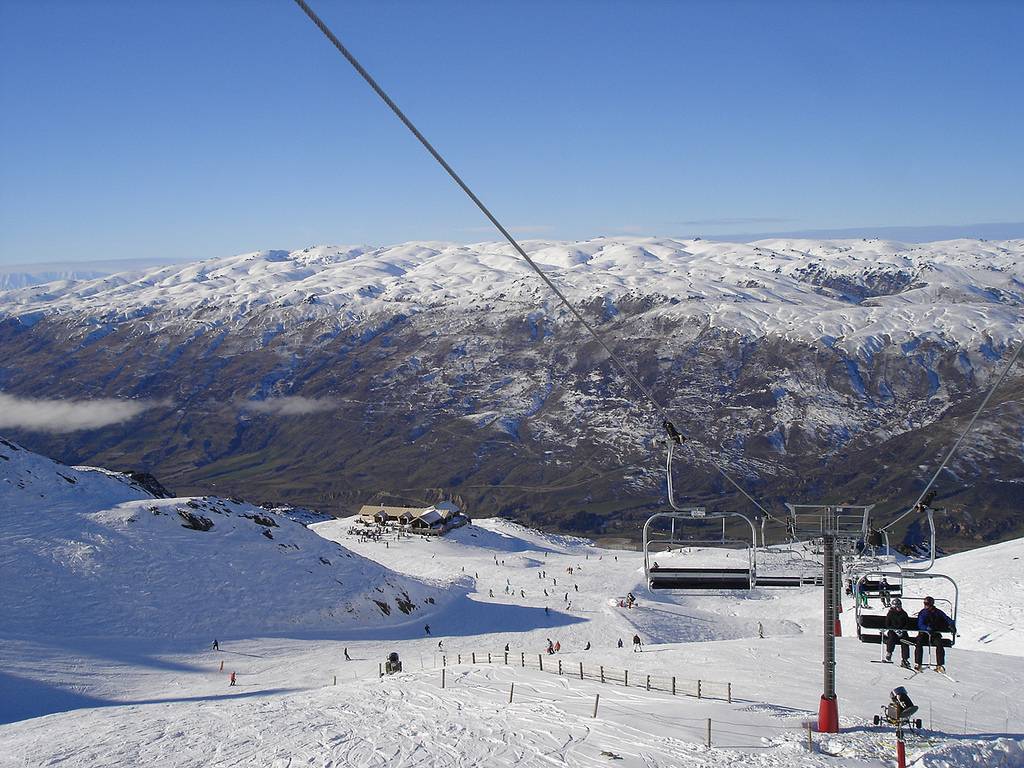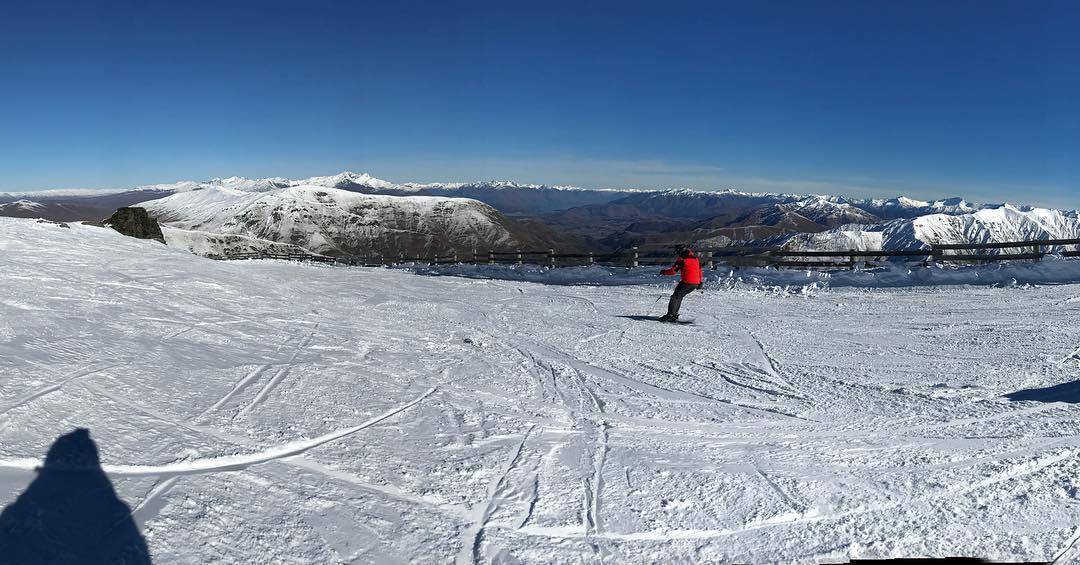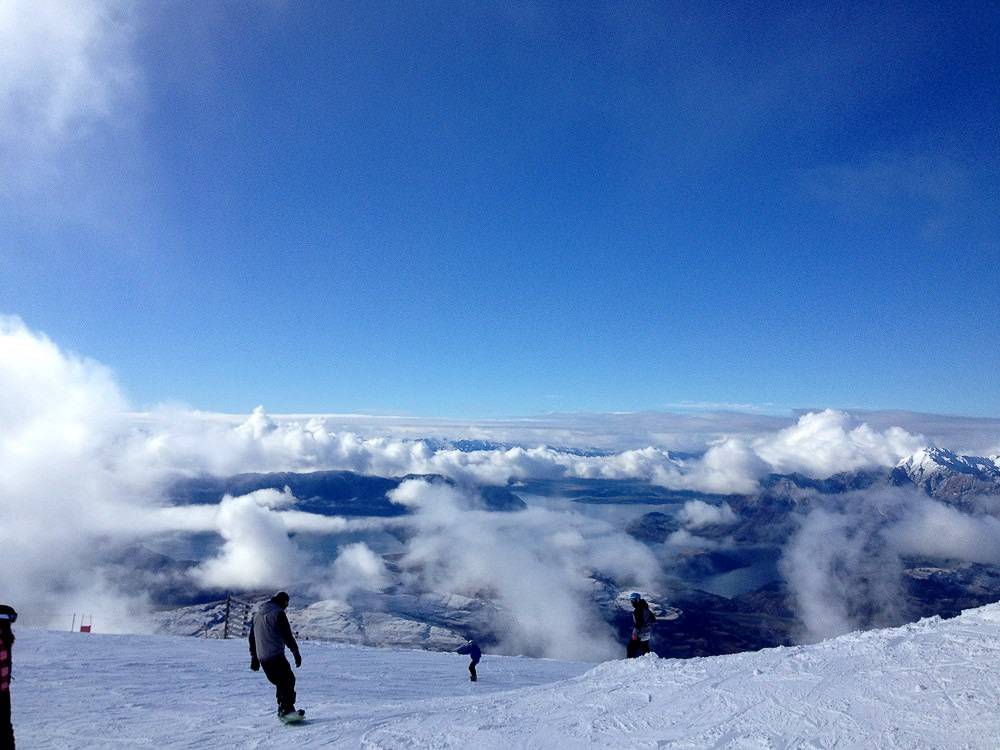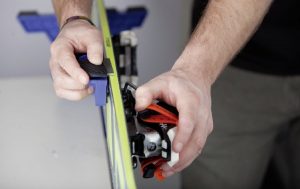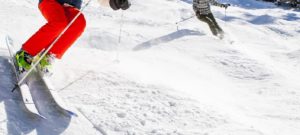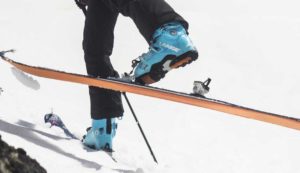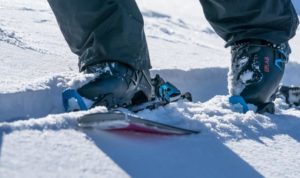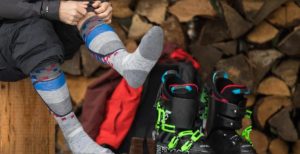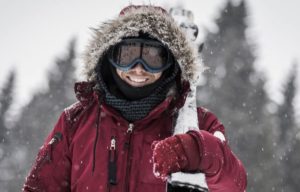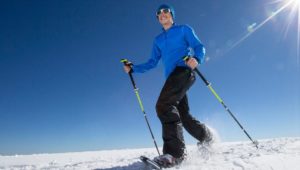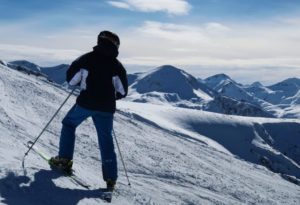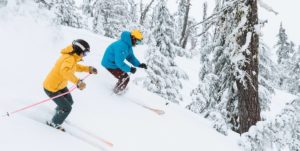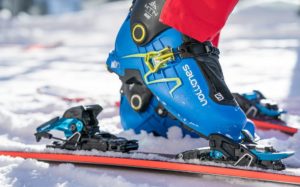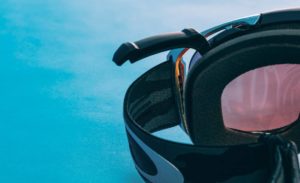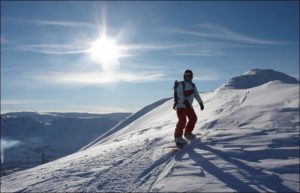The grand skiing and snowboarding vacation in Queenstown, New Zealand, last summer, included more off-snow activity options than we could possibly do in a week.
Queenstown, of course, is an internationally renowned destination for skiing, snowboarding, bungy jumping, and adventure of all kinds.
Arriving
Even when approaching Queenstown from 30,000 feet in the air at the start of a ski or snowboarding vacation, it’s clear that there’s something special down there.
Sitting on the plane’s left side, the ocean-only view gradually drifts to reveal shoreline and then some hills. Suddenly those hills become seemingly innumerable snow-capped mountain peaks.
They just stand there beneath you like a bunch of hard-frozen cones gleaming in the sun, divided by dark gray glaciers and frozen rivers. Mt. Cook. Mt. Hutt. Who can tell which is which? There are too many peaks.
The plane turns dramatically, and its wings seem to be almost touching the hills, passing Coronet Peak Ski Area closely enough that you can see tiny skiers/riders waggling down the hill. Descending further into a valley, the mountains now rising around you, the aircraft drifts slowly down to the runway.
Disembark and the Remarkables Mountains are behind you, Coronet Peak to your right. Awesome.
Just the Beginning
But, that’s just the beginning. In a day, you’re not only ascending those hills and sliding in those ski fields. You’re undertaking—if you will—thrills in the air, on the water, in the woods, and elsewhere on the ground.
Where else can you supplement a ski vacation with:
- golf
- horseback riding
- whitewater rafting
- parasailing
- hiking
- biking
- winery tours
- jet boating
- and, of course, bungy jumping?
We did ski four resorts:
But, perhaps it’s the non-skiing and snowboarding activities that make this destination so unique.
Well, that and the fact that it’s so far away.
Non-Ski/Snowboard Activities Abound
It seems, for example, that any trip to Queenstown without a bungy jump is incomplete. Or, one must at least be a spectator at a jump.
You can jump just above downtown Queenstown with A.J. Hackett Bungy, but why not stop at the site where commercial bungy got its start? The Kawarau Bridge Bungy.
The one-lane, antique bridge is a national historic landmark. Hakcet has turned it into a major jumping center, complete with gift shop and, for those who’d rather not jump, a behind the scenes tour.
The amazing thing is not that people will dive off a bridge set in a canyon 43 meters above a river. The amazing thing is that these guys have turned bungy into a multi-million dollar, international business. Some 60,000-plus people of all ages (yes, as young as 5 or 6 years old) come to this one site here annually and pay nearly NZ$200 to jump.
And, everyone jumps—nobody is ever pushed, we are told. It’s up to you to decide to go for it. Only one percent of would-be jumpers back out.
What’s more amazing is this: of all the people who come to this spot, only ten percent actually jump. That means some 600,000 people come to watch, buy souvenirs or pay NZ$20 to experience the “Secrets of Bungy” backstage tour.
An intro film is shown to Secrets participants that reviews the history of bungy jumping (it derives from a Pacific island fertility rite), and how A.J. Hacket’s jump from the Eiffel Tower gave it international recognition. Afterwards, much detail is offered about safety precautions, how the bungy chords are made, and how they decide which bungy you’ll use (there are four kinds based on weight).
The challenge, we are assured, is in the head, not the body. Jumpers experience the full range of emotions from nervousness to fear to exhilaration.
Shotover Jet
Here’s another landmark New Zealand/Queenstown tourist attraction and, like bungy, it’s just silly.
Sure , it’s exciting. And fun. But, c’mon. It’s silly.
Shotover Jet runs speed boats that cost a quarter-million dollars each, carrying up to 14 people and running in less than 10 centimeters of water, along the Shotover River through spectacular scenery—a narrow canyon, mountains in the background—whilst the pilot steers as erratically as possible, turns 360s whenever possible and brings the boat seemingly precariously close to the rocks whenever possible, all the while trying to get everyone wet.
There’s no real danger. And, as invigorating as it is, somehow it seems a waste of beautiful scenery. Said one satisfied customer afterwards “I’d like to go back through there now in a canoe so I could really take in the beauty.”
Milford Sound
Milford Sound is about 100 kilometers from Queenstown as the crow flies. As the bus drives, it’s 300-km and a four-hour ride.
You have to ask yourself this: no matter how spectacular the scenery, is it worth an eight-plus hour, round-trip bus riding day?
Hard to tell.
But, the scenery is incredible as you go through Fiordlands National Park. A snaking roadway cuts through sheer basalt cliffs and climbs to a narrow, rough-cut tunnel, then descends into a temperate rain forest.
Milford is an isolated place where there are no phone lines and everything must come in and out of town by barge-boat. The population numbers about 100, with only two kids in residence. But, in the summer, it hops with 100-plus busses and innumerable private cars and camper vans arriving daily with tourists.
Of the en-route stops, the one called The Chasm clearly stands out. Here, a paved path leads into the rain forest leading eventually to a rushing stream that has polished the rocks smooth and cut bizarre holes and shapes into them. A newly constructed boardwalk leads to a boardwalk bridge overlooking the scene.
The cruise with Real Journeys proved pleasant, but it poured rain and, while the mist makes for some dramatic shadowy vistas, it’s not the pristine spectacular view you see in photos. Such is the fate of the ski season visitor—it rains about eighty percent of the time in winter.
Still, the mountains coming to the sea are just plain spectacular, with myriad waterfalls, most of which are rain-generated and temporary, cascading huge distances and blowing spray into the wind. The hills approach 4,000 or 5,000 feet high, and submerge to equal depths.
The bottom line question about this day trip is just that—the bottom line. The cost runs $195/pp, plus $27 if you buy the unspectacular hot buffet. The total of nearly nine hours in the bus pushes the limit of acceptability. Better to overnight somewhere if one can. And one can afford it.
Queenstown
As a place that prides itself on being the adventure capital of the earth, you’d expect a lot to be happening in Queenstown.
There is.
More than 120 licensed establishments, ranging from the pretty rank and basic to sophisticated; uncountable restaurants—fast food, slow food, chains; and lodging from five-star to hostels.
You can lodge in a hostel here for as little as NZ$20/night. That’s cheap.
Or, you can overnight at a place like the new Spire Hotel, a most sumptuous place in the heart of things and home to a marvelous restaurant and bar with live jazz, for some NZ$885/night.
Our digs were the Novotel Gardens, a perfect middle of the road choice.
Given its approachable size (you can walk to almost anything), its alternative activity choices (hiking, rock climbing, bungy jumping, golf, parasailing, a marvelous city park, dinner cruises on the lake, the Kiwi Birdlife Park ice skating, in-line skating, frisbee golf, cycling—all in town), Queenstown may be the ultimate ski town.
Day 1: The Remarkables
Each of our Queenstown ski days began and ended with an adrenalin-sparking bus ride. The bus, somewhat antique and rickety, ascended the dirt road oh-so-slowly, struggling against gravity towards The Remarkables Ski Area base lodge, never leaving first gear. A most precipitous climb. Not a guard rail in sight.
In the seat across from me, Alice Moayer put her hands over her eyes, and wryly and ironically commented, “I’m sure this hand covering my eyes will save me if the bus goes over!”
It’s the views that get top reviews at The Remarkables.
The ski area was accurately described to me being excellent for novices, low intermediates and advanced skiers/riders, but with little excellent sliding for mainstream intermediates. Time to get in our ski boots and start skiing.
The pistes here are relatively short and the expert pitches not overly extreme.
The highlight for experts is mostly hike-to terrain. But, far to skiers’ left one reaches the entertaining Homeward Runs. There, a huge bowl allows wide-ranging skiing and riding until sliders emerge at a spot about a half mile down the access road where a unique kind of truck-bus provides transport back to the base.
We later hiked from the highest lift. The reason is more about ogling the spectacular scenery than to find super turns. “It’s a five-minute hike,” claims Rowan, our guide.
Right.
Fifteen minutes later, we reach the top and, indeed, the view is spectacular. Lake Wakatipu disappears into the distance, seemingly hundreds of miles away. But, no, it’s more like a stone’s throw.
We then ski down—only about a half dozen extra turns than we would’ve gotten from the lift. But, hey, it’s like the mountain climbers say: it’s because it’s there.
Kids and non-skiers flock to the Ozone Tubing Park, which requires taking a ski lift onto the main hill. And, the Up & Go Terrain Park, Superpipe and Fruju Beginner Park keep park rats of all stripes happy.
And, this just in: good news for terrain park and halfpipe denizens—The Remarkables has retained American terrain park consulting company Snow Park Technologies to redesign its terrain park offerings for the 2007 winter (North American summer) season, including a redeveloped and enlarged terrain park with two 30-meter wide, benched jump and rail lines that are twice the size of last year’s, and improved intermediate and advanced lines.
All-in-all the skiing on this chilly day resembles the skiing in the eastern U.S., both in scale and in snow texture—notwithstanding that it’s all above treeline, that the people talk with a most intriguing accent, that they drive on the wrong side of the road, and that the natives are incredibly friendly. At least I brought my ski jacket.
But, the most remarkable (no pun intended) aspect of this first day is adjusting to skiing in August.
“Isn’t it summertime?” the legs cry. “What’s up with this snowsliding?”
Day 2: Coronet Peak
The Weather Gods were smiling as we ascended yet another hairy, scary, winding, serpentine “unsealed” track (read: dirt road) to the base lodge. Indeed, snow was falling, just to make the access road more interesting (or, should we say challenging?), and the first run of the day echoed that challenge.
When you’re skiing above treeline, the last thing you want is flat light.
Well, actually, the last thing you want is fog or impaired visibility. But, flat light doesn’t help.
Nor, for that matter, does re-frozen snow that was soft yesterday, and chilled to a sturdy crust overnight.
Luckily those conditions disappeared after the first run. The sun emerged, and the snow softened perfectly.
Coronet Peak might best be described as a natural terrain park. It’s a veritable funhouse; a treeless, ski-where-you-want place filled with innumerable hillocks, rollers, pipes, gullies, bowls and natural features that just invite you to get happy.
A pair of high-speed lifts (a four-seater and a six-pack) and a large snowmaking plant make this a modern resort. There’s night skiing, too. And, since this is the closest ski field to Queenstown, it can be crowded, especially on the main pistes.
Still, diverting off piste and leaving the crowds behind proved no problem. We followed our Ski Express guide almost anywhere we pleased, constantly reminding ourselves to look up, over, back and around for skier/rider traffic that could be merging from any direction.
The U.S. Ski Team was training here during our visit, and there was a major slalom race to be staged the next day. That is probably sufficient evidence that there’s enough steep at Coronet. While the advanced runs aren’t that numerous, some superior black diamond descents were to be found a short hike up from the quad, then off to skiers’ left, where the trail ducks down into a valley, with some sharp drops and rollers, sporting some excellent bump fields.
Since I had recently sworn off hiking for turns (yesterday’s trudge to the top at The Remarkables notwithstanding), I settled for bouncing off the topographic halfpipe and quarterpipe sidewalls.
A definite hoot.
And, as throughout the trip, friendliness prevailed. This ski station has been around since the late ‘40s, starting with a rope tow, and it carries on with a “we’re all in it for the good times” ambiance.
Day 3: Cardrona Resort
A perfect day. Not a cloud. Temps rising well above freezing. Only a mild bit of wind at the top.
This isn’t the largest of ski areas, but like its brethren, it’s wide open. And, when the snow is perfect like it was that day— literally perfect packed powder—it’s hard to be too critical.
We followed a guide who calls himself Fly, who’s name fit his personality. Full of vim and vigor Fly talked nonstop, but he managed to lead us to some pretty special places.
We explored a few steep pitches that were littered among the cruising routes, and found some delightful turns between large rocks and off cat tracks. Come afternoon, we drifted out to skiers’ far left and paused to watch an WWII-era plane buzz the valley and do a few loops, augmenting wonderfully the endless views back towards Queenstown, down to Lake Wanaka and over towards Mt. Cook.
On the other side of the valley stands a small snowsport station that’s terrain park and halfpipe only. It’s called Snow Park, and it was created and designed by the same guy who does the X-Games facilities for Aspen at Buttermilk. Up there, too, is a huge complex of Nordic ski trails. Unfortunately, this trip allows for exploring neither facilities.
Not that Cardrona is short on freestyle/freeride facilities. Consider:
- One of the largest pipe and terrain parks in the Southern Hemisphere featuring up to four halfpipes and three terrain parks.
- New Zealand’s longest terrain park with two trails running the length of the Whitestar Express chair, on a purpose built terraced course. The Heavy Metal park for advanced riders and bigger features, the Playzone park that runs along the upper part of Heavy Metal with smaller features and the beginners’ park for first-timers.
- The Gravity Cross course challenges skiers and snowboarders through the season—800 meters of curves, bumps and berms.
Nor are beginners forgotten here. Novices benefit from three Magic Learner lifts and a beginner quad chair all their own.
The base lodge buildings are painted a bright sunshine yellow, like something from the Caribbean. Among the food offerings is a unique eatery called Noodles, set in an ancillary building that requires climbing three flights of stairs. They serve Chinese in Noodles, rather unusual for a ski resort base lodge. And it’s uniquely served: you order at the counter, and it comes to your table served in classic Chinese food take-away boxes.
We finished our day by following something called the Secret Route, which skirted far to skiers’ left and led to some steep drops among huge rocks. A lot of fun, to be sure. Enough fun, in fact, that I don’t think it’s much of a secret.
Day 4: Treble Cone
Looks like we saved the best for last.
Not that any of our other New Zealand ski stops were bad ones. But, you’ll always have a favorite among ski-snowboard resort destinations, and on this trip it was Treble Cone for me.
The place has only two lifts, three if you count the beginner slope t-bar. So, go figure how it managed to achieve the closest thing to big-time skiing we encountered.
And, in a world of black-diamond access roads, this one took the cake. At one point the man from Holidaze Ski Tours, Bob McEarlen called out, “Jeez – when you look out the window, you could think you were in an airplane.”
Steep? Yes. The bus could progress only in first gear.
Severe drop-offs? Yes. You could all-too-easily imagine the vehicle rolling into oblivion.
Nerve wracking? You betcha—especially when I thought about the brakes giving out on the downhill return.
A gondola rising from the valley flats is proposed for accessing the ski fields here. Hopefully for 2008. That would not only eliminate the nervous time, but it would cut the travel time by at least half an hour.
Once you’re up there, however, a superb world of white opens.
Once again, it’s all treeless, wide open terrain, but here there are numerous spots to dart among large rocks into chutes, gullies, and natural half pipes. There are about 2,000 feet of vertical, too.
Some of the steep is seriously steep. One adventurous member of our group called the terrain to far skiers’ right “some of the best extreme terrain I’ve ever skied.” And, vast amounts of hike-to terrain is also accessible.
Friends and I ventured in the afternoon out to a spot called The View, at far skiers’ left. Clearly the name speaks for itself. But, there we found a run named Outer Limits. Because we’d all skied innumerable days at Vermont’s Killington Resort, where Outer Limits ranks among the steepest bump runs anywhere, we felt compelled to ski this Outer Limits, too.
At Treble Cone, Outer Limits lead into a huge bowl that, at one point was completely empty of skiers except for we three skiers and our guide Paula.
Spectacular doesn’t begin to describe it: the skiing, the views or the feeling.
And those views? Oh my.
A narrow valley held the foreground with Lake Wanaka carrying off into the distance surrounded by stark brown/green hills and containing a small roundish island in its middle. Altogether it resembled a major volcanic caldera. But, no, its glacier-formed. The volcanoes are on the North Island.
This was not only the best skiing but the best weather too. The base lodge was too small to handle the bodies, but the sun allowed the crowds to spill out onto the concrete deck, and the food proved excellent—especially for base lodge fare. We’re talking about huge salmon or tofu burgers and other very tasty hot dishes.
Back on the snow, we cruised for all we were worth. This was a day that we never wanted to end. On a trip that could’ve been twice as long. But, mostly, nobody wanted to drive back down that access road!

